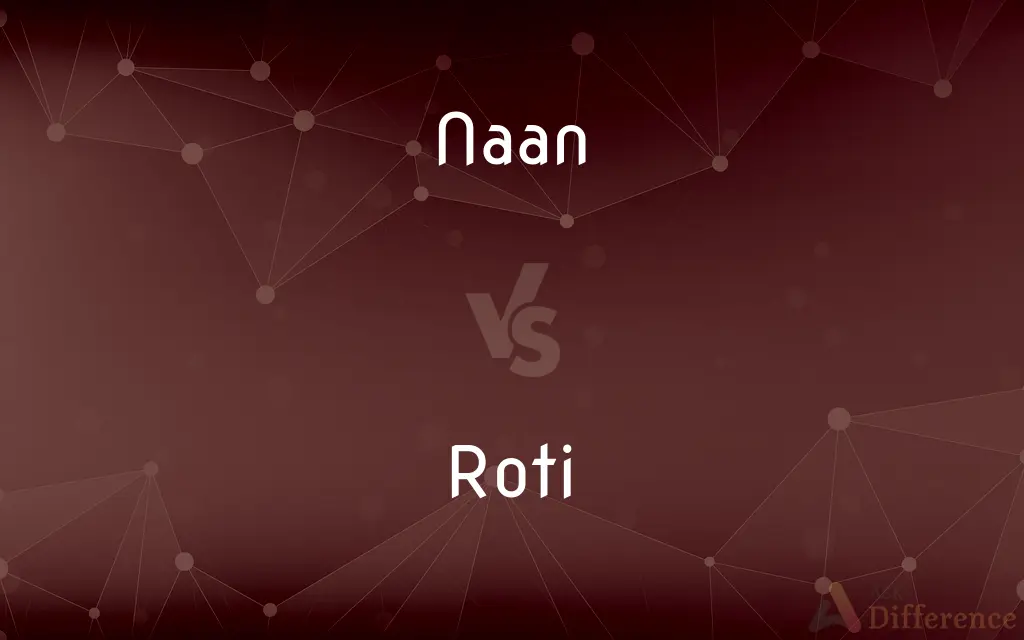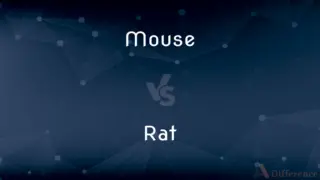Naan vs. Roti — What's the Difference?
By Tayyaba Rehman — Updated on September 23, 2023
Naan is a soft, leavened bread often made with yogurt and baked in a tandoor, while Roti is a simple, unleavened flatbread cooked on a griddle.

Difference Between Naan and Roti
Table of Contents
ADVERTISEMENT
Key Differences
Naan and Roti are both types of flatbreads commonly associated with Indian cuisine. Naan is a leavened bread, which means it includes ingredients like yeast or baking powder that allow it to rise. It's often enriched with ingredients like yogurt, milk, or eggs, giving it a soft and fluffy texture. On the contrary, Roti, also known as chapati, is an unleavened bread made with just whole wheat flour and water, resulting in a more rustic, chewy texture.
When it comes to cooking methods, Naan and Roti differ noticeably. Naan is traditionally baked in a tandoor, a cylindrical clay or metal oven. This method of cooking provides Naan with its characteristic charred spots and smoky flavor. Roti, in contrast, is typically cooked on a flat griddle or tava. The high heat from the griddle gives Roti its light browning and occasional bubbles.
In terms of serving, both Naan and Roti are versatile accompaniments to various dishes. Naan, because of its soft texture, often pairs well with rich gravies and spicy curries. Roti, being a daily staple in many Indian homes, complements everything from vegetables to lentils.
Regarding regional variations, both Naan and Roti have different versions across the Indian subcontinent and beyond. For instance, Naan might be brushed with ghee (clarified butter) and sprinkled with garlic or nigella seeds. Meanwhile, variations of Roti include the stuffed paratha or the crispy, flaky Malabar parotta.
Comparison Chart
Leavening
Leavened (uses yeast or baking powder)
Unleavened
ADVERTISEMENT
Main Ingredients
Often contains yogurt, milk, or eggs
Usually just whole wheat flour and water
Cooking Method
Baked in a tandoor
Cooked on a griddle (tava)
Texture
Soft and fluffy
Rustic and chewy
Common Pairings
Pairs well with rich gravies and curries
Complements everything from vegetables to lentils
Compare with Definitions
Naan
A leavened Indian bread baked in a tandoor.
I ordered butter chicken with garlic Naan.
Roti
A bread that can be rolled thin or kept thick.
I like my Roti rolled thin and lightly roasted.
Naan
An accompaniment to many Indian meals.
The spicy lamb curry goes well with Naan.
Roti
A simple bread made primarily from wheat flour and water.
Freshly made Roti with butter is a treat.
Naan
A bread with variations like garlic or cheese.
I prefer cheese Naan with my tikka masala.
Roti
An unleavened Indian flatbread cooked on a griddle.
Roti is a staple in many Indian households.
Naan
A soft flatbread often containing yogurt.
Naan with a touch of melted butter is irresistible.
Roti
A versatile accompaniment to a range of dishes.
Roti is often eaten with dals or lentil curries.
Naan
Flatbread that's often thicker than Roti.
I like to dip Naan into creamy lentil dal.
Roti
Also known as chapati in some regions.
I enjoy Roti with a side of mixed vegetables.
Naan
Naan (Persian: نان, romanized: nān, Pashto : نان Dari: نان, Punjabi: ਨਾਨ, Hindi: नान, Bengali: নান) is a leavened, oven-baked flatbread found in the cuisines mainly of Western Asia, Indian subcontinent, Indonesia, Myanmar and the Caribbean.
Roti
Roti (also known as chapati) is a round flatbread native to the Indian subcontinent made from stoneground whole wheat flour, traditionally known as gehu ka atta, and water that is combined into a dough. Roti is consumed in many countries worldwide.
Naan
A flat, leavened bread of northwest India, made of wheat flour and baked in a tandoor.
Roti
See chapati.
Naan
A type of round, flat bread baked in a tandoor popular in South and Central Asian cuisine.
Roti
A kind of unleavened flatbread commonly consumed in South Asia and the Caribbean.
Nepalis eat sweet fried rice-flour doughnuts called sel roti.
Common Curiosities
What's the primary difference in their ingredients?
Naan often contains yogurt, milk, or eggs, while Roti is usually made with just wheat flour and water.
Is Roti the same as chapati?
Yes, Roti is often referred to as chapati in many regions.
What kind of bread is Naan?
Naan is a leavened Indian bread, often made with yogurt and baked in a tandoor.
Is Roti healthier than Naan?
Roti, being simpler and often whole grain, is generally considered healthier than the richer Naan.
Can Naan be made without a tandoor?
Yes, Naan can be made in an oven or even on a stovetop, but it might lack the traditional smoky flavor.
Are there different versions of Naan?
Yes, there are variations like garlic Naan, cheese Naan, and more.
Are Naan and Roti vegan?
Roti usually is, but Naan might contain dairy or eggs.
Is it common to add fillings inside Naan or Roti?
While Roti can be eaten plain or as a wrap, Naan can have fillings or toppings like garlic or cheese.
How does Roti differ from Naan in texture?
Roti is generally rustic and chewy, while Naan is soft and fluffy.
Which bread is softer, Naan or Roti?
Naan is generally softer due to its leavening agents and additional ingredients like yogurt.
How are Naan and Roti served?
Both are typically served warm, often with curries, dals, or other Indian dishes.
Can Naan and Roti be made gluten-free?
Yes, with alternative flours, but the texture and taste might vary.
Can you store leftover Naan and Roti?
Yes, but they're best consumed fresh. If stored, they should be reheated before serving.
Which one is more popular in India?
Roti is a daily staple in many homes, while Naan is often reserved for special occasions or restaurant meals.
Which one is easier to make at home?
Roti is simpler and requires fewer ingredients than Naan.
Share Your Discovery

Previous Comparison
Brilliant vs. Brilliance
Next Comparison
Mouse vs. RatAuthor Spotlight
Written by
Tayyaba RehmanTayyaba Rehman is a distinguished writer, currently serving as a primary contributor to askdifference.com. As a researcher in semantics and etymology, Tayyaba's passion for the complexity of languages and their distinctions has found a perfect home on the platform. Tayyaba delves into the intricacies of language, distinguishing between commonly confused words and phrases, thereby providing clarity for readers worldwide.
















































